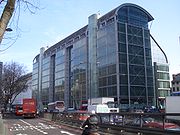- ChEMBL
-
ChEMBL 
Content Description Biological database Data types captured Molecules with drug-like properties and biological activity Contact Research center European Molecular Biology Laboratory Laboratory  European Bioinformatics Institute
European Bioinformatics InstituteAuthors John Overington, Team Leader Primary Citation PMID 21936816 Release date 2009 Access Website ChEMBL Download URL Downloads Sparql endpoint SNORQL Tools Miscellaneous License The ChEMBL data is made available on a Creative Commons Attribution-Share Alike 3.0 Unported License Versioning Chembl_11 ChEMBL or ChEMBLdb is a manually curated chemical database of bioactive molecules with drug-like properties.[1] It is maintained by the European Bioinformatics Institute (EBI), based on the Wellcome Trust Genome Campus, Hinxton, UK. The database, originally known as StARlite, was developed by a biotechnology company, Inpharmatica Ltd. latterly acquired by Galapagos NV. The data was acquired for EMBL in 2008 with an award from The Wellcome Trust, resulting in the creation of the ChEMBL chemogenomics group at EBI, led by John Overington.[2][3]
Contents
Scope and access
ChEMBL version 2 (ChEMBL_02) was launched in January 2010, including 2.4 million bioassay measurements covering 622,824 compounds, including 24,000 natural products. This was obtained from curating over 34,000 publications across twelve medicinal chemistry journals. ChEMBL's coverage of available bioactivity data has grown to become "the most comprehensive ever seen in a public database.".[2] In October 2010 ChEMBL version 8 (ChEMBL_08) was launched, with over 2.97 million bioassay measurements covering 636,269 compounds.[4]
ChEMBL_10 saw the addition of the PubChem confirmatory assays, in order to integrate data that is comparable to the type and class of data contained within ChEMBL.[5]
ChEMBLdb can be accessed via a web interface or downloaded by File Transfer Protocol. It is formated in a manner amenable to computerized data mining, and attempts to standardize activities between different publications, to enable comparative analysis.[1] ChEMBL is also integrated into other large-scale chemistry resources, including PubChem and the ChemSpider system of the Royal Society of Chemistry.
Associated resources
In addition to the database, the ChEMBL group have developed tools and resources for data mining.[6] These include Kinase SARfari, an integrated chemogenomics workbench focussed on kinases. The system incorporates and links sequence, structure, compounds and screening data. GPCR SARfari is a similar workbench focussed on GPCRs and ChEMBL-Neglected Tropical Diseases (ChEMBL-NTD) is a repository for Open Access primary screening and medicinal chemistry data directed at endemic tropical diseases of the developing regions of the Africa, Asia, and the Americas. The primary purpose of ChEMBL-NTD is to provide a freely accessible and permanent archive and distribution centre for deposited data.[2]
See also
References
- ^ a b Gaulton, A; et al. (2011). "ChEMBL: a large-scale bioactivity database for drug discovery". Nucleic Acids Research. doi:10.1093/nar/gkr777.
- ^ a b c Bender, A (2010). "Databases: Compound bioactivities go public". Nature Chemical Biology 309 (6). doi:10.1038/nchembio.354. http://www.nature.com/nchembio/journal/v6/n5/full/nchembio.354.html. Retrieved 2010-11-15.
- ^ Overington J (April 2009). "ChEMBL. An interview with John Overington, team leader, chemogenomics at the European Bioinformatics Institute Outstation of the European Molecular Biology Laboratory (EMBL-EBI). Interview by Wendy A. Warr". J. Comput. Aided Mol. Des. 23 (4): 195–8. doi:10.1007/s10822-009-9260-9. PMID 19194660.
- ^ ChEMBL-og (15 November 2010), ChEMBL_08 Released, http://chembl.blogspot.com/2010/11/chembl08-released.html, retrieved 2010-11-15
- ^ ChEMBL-og (6 June 2011), ChEMBL_10 Released, http://chembl.blogspot.com/2011/06/chembl-10-released.html, retrieved 2011-06-09
- ^ Bellis, L J; et al. (2011). "Collation and data-mining of literature bioactivity data for drug discovery.". Biochemical Society Transactions 39: 1365. doi:10.1042/BST0391365. http://www.biochemsoctrans.org/bst/039/bst0391365.htm. Retrieved 2011-24-09.
External links
- ChEMBLdb
- Kinase SARfari
- ChEMBL-Neglected Tropical Disease Archive
- GPCR SARfari
- The ChEMBL-og Open data and drug discovery blog run by the ChEMBL team.
Wellcome Trust Centres and institutes CurrentFrancis Crick Institute · Science Learning Centres · Wellcome Trust Centre for Cell-Matrix Research · Wellcome Trust Centre for Gene Regulation and Expression · Wellcome Trust Centre for Neuroimaging · Wellcome Trust Centre for Stem Cell Research · Wellcome Trust Sanger InstituteFormerWellcome Trust Centre for the History of MedicinePlannedSainsbury Wellcome Centre for Neural Circuits and Behaviour
Programmes, databases
and projectsCancer Genome Project · ChEMBL · COSMIC cancer database · DECIPHER · Ensembl · Human Genome Project · Malawi Liverpool Wellcome Trust · MEROPS · Pfam · Rfam · UK Biobank · WormBasePlaces and facilities People Other Big Picture · Genome Reference Consortium · The London Museums of Health & Medicine · Wellcome Collection · Wellcome Library · Wellcome Trust Book Prize · List of wealthiest charitable foundations
Categories:- Bioinformatics
- Biological databases
- Chemical databases
- Cheminformatics
- Wellcome Trust
Wikimedia Foundation. 2010.
